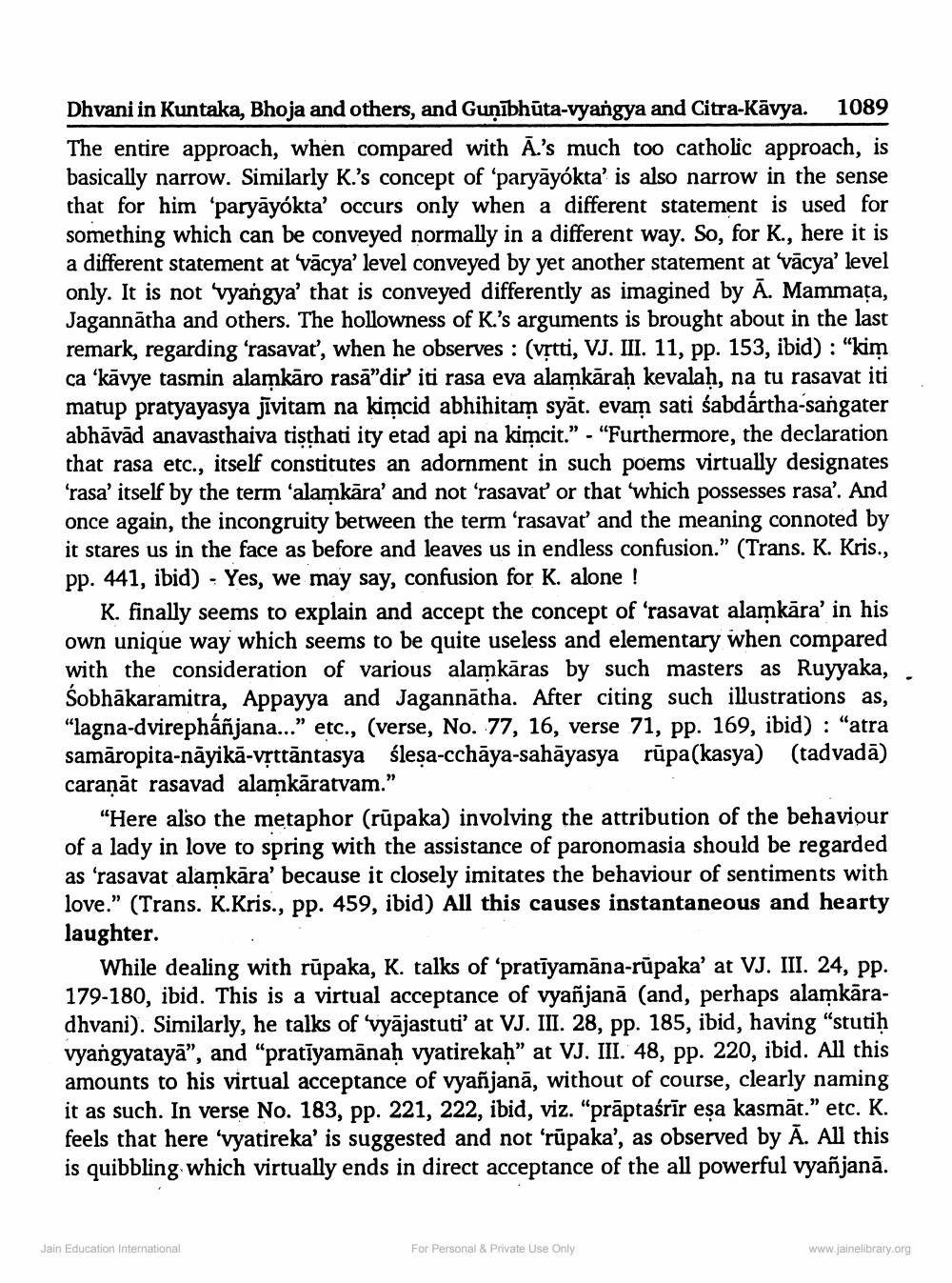________________
Dhvani in Kuntaka, Bhoja and others, and Gunībhūta-vyangya and Citra-Kāvya. 1089 The entire approach, when compared with Ā.'s much too catholic approach, is basically narrow. Similarly K.'s concept of 'paryāyókta’ is also narrow in the sense that for him paryayókta' occurs only when a different statement is used to something which can be conveyed normally in a different way. So, for K., here it is a different statement at vācya' level conveyed by yet another statement at vācya' level only. It is not vyangya' that is conveyed differently as imagined by A. Mammața, Jagannātha and others. The hollowness of K's arguments is brought about in the last remark, regarding 'rasavat', when he observes : (vrtti, VJ. III. 11, pp. 153, ibid): "kim ca 'kāvye tasmin alamkāro rasā”dir iti rasa eva alamkārah kevalah, na tu rasavat iti matup pratyayasya jivitam na kimcid abhihitam syāt. evam sati śabdártha-sangater abhāvād anavasthaiva tisthati ity etad api na kimcit." - "Furthermore, the declaration that rasa etc., itself constitutes an adornment in such poems virtually designates 'rasa' itself by the term 'alamkāra' and not 'rasavat' or that which possesses rasa'. And once again, the incongruity between the term 'rasavat' and the meaning connoted by it stares us in the face as before and leaves us in endless confusion.” (Trans. K. Kris., pp. 441, ibid) - Yes, we may say, confusion for K. alone !
K. finally seems to explain and accept the concept of 'rasavat alamkāra' in his own unique way which seems to be quite useless and elementary when compared with the consideration of various alamkāras by such masters as Ruyyaka, Sobhākaramitra, Appayya and Jagannātha. After citing such illustrations as, "lagna-dvirepháñjana...” etc., (verse, No. 77, 16, verse 71, pp. 169, ibid) : "atra samāropita-nāyikā-výttāntasya ślesa-cchāya-sahāyasya rūpa(kasya) (tadvadā) caranāt rasavad alamkāratvam."
"Here also the metaphor (rūpaka) involving the attribution of the behaviour of a lady in love to spring with the assistance of paronomasia should be regarded as 'rasavat alamkāra' because it closely imitates the behaviour of sentiments with love." (Trans. K.Kris., pp. 459, ibid) All this causes instantaneous and hearty laughter.
While dealing with rūpaka, K. talks of 'pratīyamāna-rūpaka' at VJ. III. 24, pp. 179-180, ibid. This is a virtual acceptance of vyañjanā (and, perhaps alamkāradhvani). Similarly, he talks of vyājastuti' at VJ. III. 28, pp. 185, ibid, having "stutih vyangyatayā", and "pratīyamānah vatirekah" at VJ. III. 48, pp. 220, ibid. All this amounts to his virtual acceptance of vyañjanā, without of course, clearly naming it as such. In verse No. 183, pp. 221, 222, ibid, viz. "prāptaśrīr eșa kasmāt.” etc. K. feels that here 'vyatireka' is suggested and not 'rūpaka', as observed by Ā. All this is quibbling which virtually ends in direct acceptance of the all powerful vyañjanā.
Jain Education International
For Personal & Private Use Only
www.jainelibrary.org




